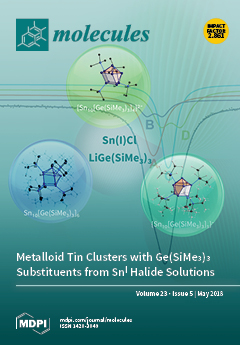As a continuation of searching for phytoconstituents that act as promising agents for antimicrobial therapy, rare coumarins were isolated from fruits of
Peucedanum luxurians and tested. In a first step, the content of major compounds in the aerial parts and fruits of
P.
[...] Read more.
As a continuation of searching for phytoconstituents that act as promising agents for antimicrobial therapy, rare coumarins were isolated from fruits of
Peucedanum luxurians and tested. In a first step, the content of major compounds in the aerial parts and fruits of
P. luxurians were compared. The results clearly showed that the fruits with dichloromethane as a solvent yielded, in most cases, higher concentrations of almost all the analyzed coumarins than the aerial parts, with peucedanin detected as the most abundant compound with a concentration of 4563.94 ± 3.35 mg/100 g. Under this perspective, the dichloromethane extract from the fruits of
P. luxurians was further submitted to high performance countercurrent chromatography with a mixture of
n-hexane, ethyl acetate, methanol, and water 6:5:6:5 (
v/
v). Combination of HPCCC and prep-HPLC yielded 6′,7′-dihydroxybergamottin (
1), officinalin (
2), stenocarpin isobutyrate (
3), officinalin isobutyrate (
4), 8-methoxypeucedanin (
5), and peucedanin (
6). Isolated compounds were tested against several Gram-positive and Gram-negative bacteria strains. 6′,7′-Dihydroxybergamottin, peucedanin, and officinalin isobutyrate appeared to be the most active against all tested bacteria strains with minimum inhibitory concentration (MIC) values between 1.20 and 4.80 mg/mL. To the best of our knowledge, this is the first report about countercurrent isolation of mentioned coumarins, as well as the first information about their antimicrobial activity.
Full article






